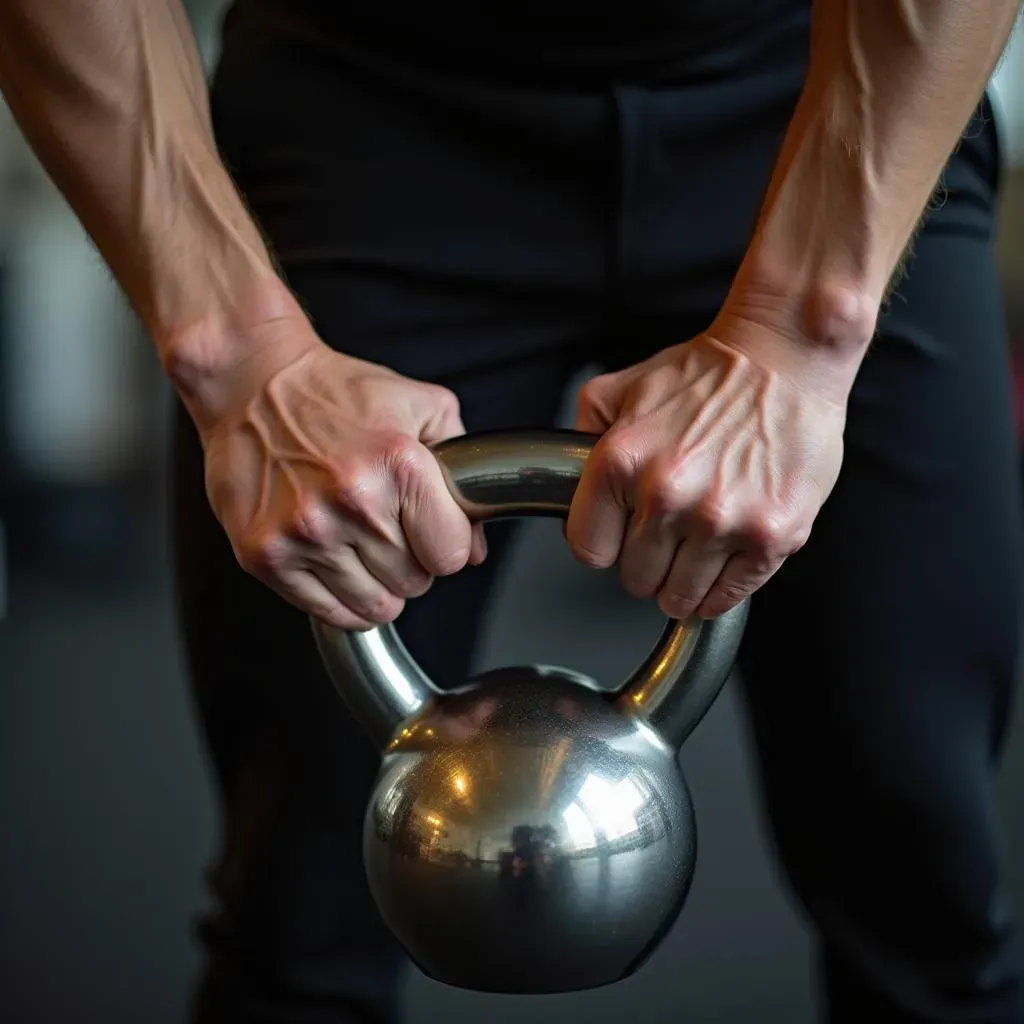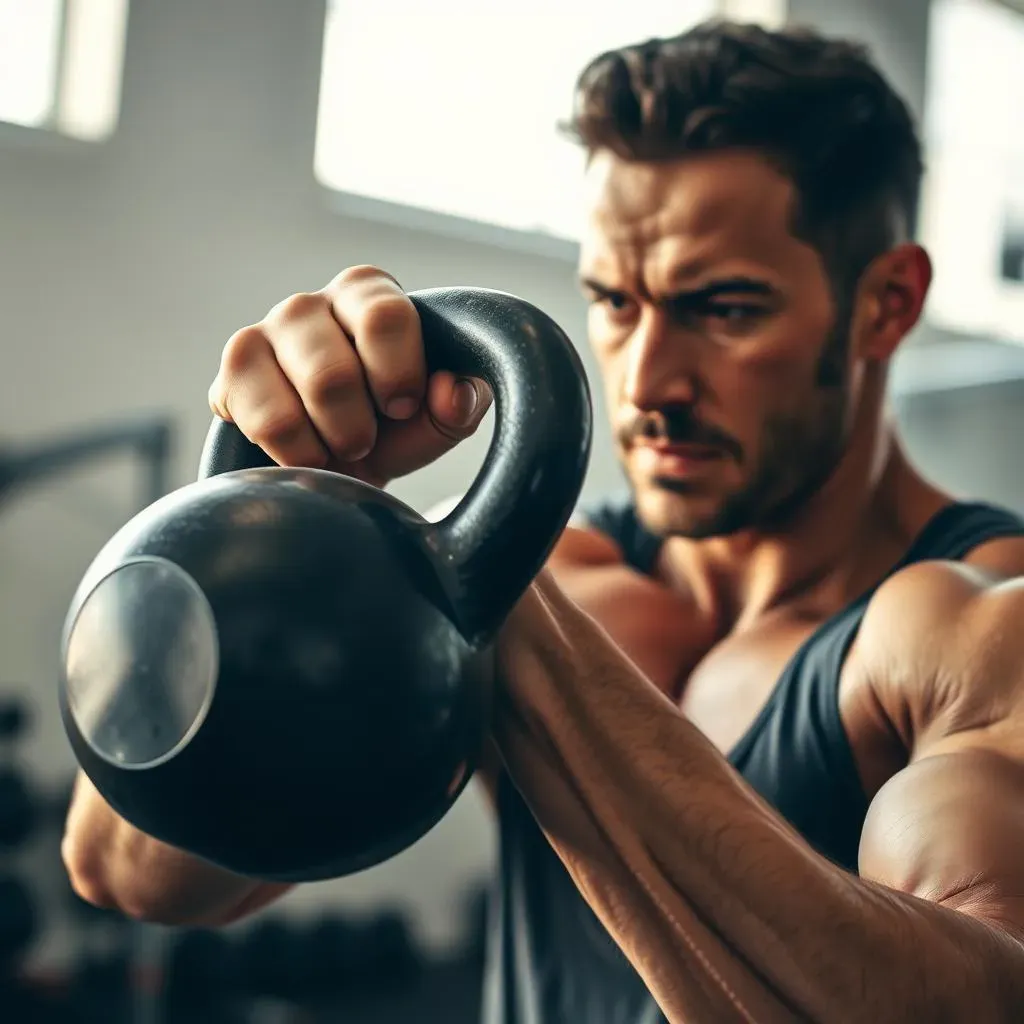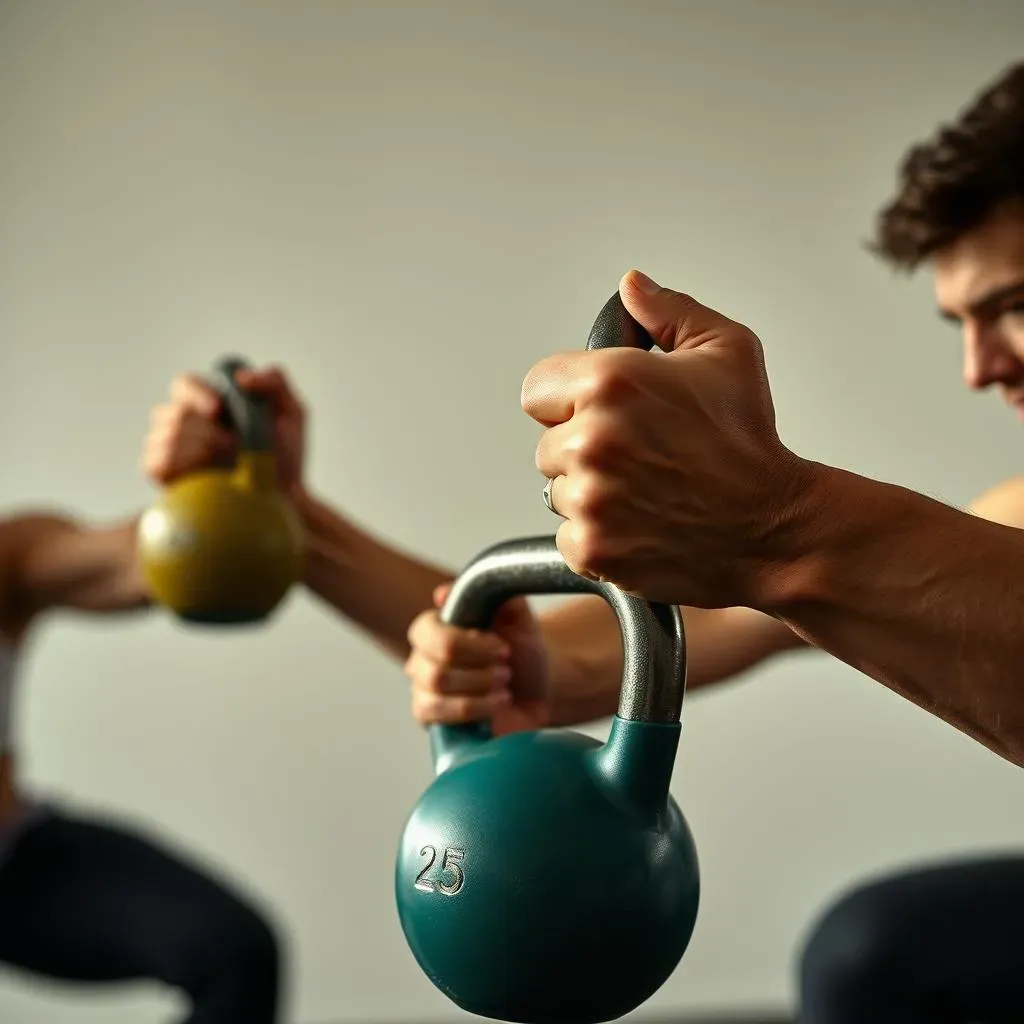Table of Contents
Ever picked up a kettlebell and thought, "I'll just do some curls"? Me too. But here’s the thing, a kettlebell curl isn't just a bicep party. It's a full-blown upper body bash. We often think of curls as the go-to for big biceps, but the kettlebell variety is sneaky, working muscles you didn’t even know you had. This article isn't your average "lift heavy, get big" spiel. We're going to break down exactly which muscles are getting in on the action when you perform a kettlebell curl. We'll explore the standard curl, then we’ll get into the nitty-gritty of variations like the crush curl. Ever wonder why you get tired faster with kettlebells? We'll tackle that too. Get ready to discover how to make the most of your kettlebell curls and learn all about the kettlebell curl muscles worked, and why you should ditch the dumbbells for a bit. Let's get to it!
The Kettlebell Curl: More Than Just Biceps

The Kettlebell Curl: More Than Just Biceps
The Usual Suspects: Biceps, Obviously
let's get the obvious out of the way. When you think of curls, you think biceps, right? Absolutely. The kettlebell curl does indeed hammer those guns. You'll feel the burn in the front of your upper arm, that's your biceps brachii flexing like a boss. But the thing about kettlebells is their weight distribution. Unlike a dumbbell, the kettlebell's weight isn't evenly spread, making your biceps work a bit differently, and often harder, to stabilize the load. I always find that my biceps feel way more engaged with a kettlebell than a dumbbell. It's like they’re working overtime to keep that bell from swinging all over the place.
It's not just about flexing for the mirror, though, is it? The kettlebell curl is also about functional strength. Think about picking up heavy groceries or lifting a kid. These actions require more than just bicep strength; they require a coordinated effort from your entire upper arm. The kettlebell curl, because of the uneven weight, trains your muscles in a way that translates to real-life movements.
Beyond the Biceps: Engaging the Forearms
Now, let’s move beyond the biceps and talk about the unsung heroes of the kettlebell curl: your forearms. Those muscles that run from your elbow to your wrist? They are working harder than you think. Because of the kettlebell’s shape, your forearms are constantly engaged to grip and stabilize the weight. This means you’re not just building bicep strength, you’re also getting a good workout for your forearms, which are crucial for overall grip strength. This is why I find that a good session of kettlebell curls leaves my forearms feeling just as fatigued as my biceps. It's a two-for-one deal, and who doesn't love that?
Here's a fun fact: The brachioradialis, a muscle on the thumb side of your forearm, gets a lot of love during kettlebell curls. It helps with elbow flexion, and it really kicks in when you're trying to keep that kettlebell from wobbling. This engagement means a more balanced and functional arm workout. So, next time you’re curling, pay attention to that forearm burn – it’s a sign you're doing it right.
Muscle Group | Primary Function | How Kettlebell Curls Engage It |
|---|---|---|
Biceps Brachii | Elbow flexion, forearm supination | Primary muscle worked during the curl |
Brachialis | Elbow flexion | Works alongside biceps for flexion |
Brachioradialis | Elbow flexion, forearm pronation/supination | Stabilizes the wrist and forearm during movement |
Forearm Muscles | Grip, wrist stabilization | Engaged to control and stabilize the kettlebell |
The Stabilizers: Shoulder and Upper Back
You might not think about it, but your shoulders and upper back are also involved in the kettlebell curl. These muscles act as stabilizers, helping you maintain good posture and control the movement. The anterior deltoid (the front of your shoulder) works to keep your arm stable as you curl, while the muscles in your upper back help prevent you from hunching over. This is why you might feel a bit of a burn in your shoulders during a set of curls. It's not just about the biceps; it’s about the entire upper body working in harmony.
I’ve noticed that when I focus on keeping my core engaged and my posture upright, I get a much better workout. Not only does it help with stability, but it also helps prevent any unwanted strain on my lower back. So, while you’re focused on your biceps, remember that the kettlebell curl is secretly a full-body exercise. And that’s what makes it so awesome. It's not just about building big arms; it's about building a strong, stable upper body.
Crushing It: How the Crush Curl Engages More Muscles

Crushing It: How the Crush Curl Engages More Muscles
The Crush Grip: A Game Changer
so we’ve covered the regular kettlebell curl, but now let's talk about the crush curl. This is where things get interesting. The crush curl isn't just about lifting the weight; it's about *how* you hold it. Instead of gripping the handle like usual, you hold the kettlebell by the sides of the bell itself, almost like you’re trying to crush it. This grip shift changes everything. It instantly activates more muscles in your hands, forearms, and even your chest. I remember the first time I tried it, I was surprised by how much more challenging it felt, even with the same weight. It's like the kettlebell is putting up a fight, and your muscles have to work harder to win.
The reason the crush grip is so effective is because it forces you to engage muscles that are often neglected in standard curls. Your forearms are working overtime to keep the kettlebell from slipping, while your chest muscles are activated to keep the bell close to your body. It's a full-body engagement that makes the exercise much more efficient. I've found that the crush curl is a fantastic way to add some spice to my workout routine. It feels like a whole new exercise, even though it’s just a slight variation on the standard curl.
More Than Just Biceps: Chest and Shoulder Activation
With the crush curl, the muscle activation isn't just limited to your arms. The position you hold the kettlebell encourages the engagement of your chest, particularly the pectoralis major muscles. You have to squeeze your chest to keep the kettlebell from dropping, which is a cool way to get extra muscle activation. It’s not a chest exercise like a push-up, but it definitely adds some extra work in the area. I’ve noticed that I feel it in my chest during and after crush curls, which is a great bonus. It’s like getting a little extra something for your trouble.
Also, your shoulders get a good workout during the crush curl. The anterior deltoids and even some of the rotator cuff muscles are engaged to stabilize the kettlebell and maintain proper form. This makes the crush curl a great compound exercise that works multiple muscle groups simultaneously. I’ve found that the crush curl is a good way to strengthen my shoulders without having to do a bunch of isolated shoulder exercises. So, if you’re looking for an efficient way to work your arms, chest, and shoulders, the crush curl is definitely worth trying. It’s like a sneaky way to get a full upper-body workout in one exercise.
Muscle Group | How It's Engaged in Crush Curl |
|---|---|
Forearms | Increased grip strength needed to hold the kettlebell |
Chest (Pectoralis Major) | Activated to stabilize the kettlebell and keep it close to the body |
Anterior Deltoids | Work to stabilize the shoulder during the movement |
Biceps | Still the primary mover, but with increased demand for stabilization |
Kettlebell Curl Variations: Targeting Different Muscle Groups

Kettlebell Curl Variations: Targeting Different Muscle Groups
Hammer Curls: A Forearm Focused Variation
Alright, so you're getting the hang of the standard and crush curls, but what if I told you there are even more ways to play with the kettlebell? Let's talk about hammer curls. This variation is all about your forearms. Instead of curling the kettlebell with your palms facing up, you hold it with your palms facing each other, like you’re holding a hammer. This simple change shifts the emphasis from your biceps to your brachioradialis, which is that muscle on the thumb side of your forearm. I find that hammer curls not only build forearm strength but also give your grip a serious workout. It's a great way to balance out your arm development and make sure you’re not just building biceps.
I remember when I first started doing hammer curls, I was surprised by how much of a difference such a small change in grip could make. My forearms were burning in a new way, and I felt like I was working muscles I had never really targeted before. Plus, hammer curls are super functional. Think about all the times you need a strong grip in daily life – carrying heavy bags, opening jars, or even just holding onto a slippery object. Hammer curls are a great way to make sure your forearms are up to the task. So, next time you're doing your arm workout, give hammer curls a shot. You might just discover a new favorite variation.
Variation | Grip | Primary Focus |
|---|---|---|
Standard Curl | Palms facing up | Biceps |
Crush Curl | Holding sides of the bell | Biceps, Forearms, Chest |
Hammer Curl | Palms facing each other | Forearms (Brachioradialis) |
Concentration Curls: Isolating the Biceps
Now, if you’re looking to really zero in on your biceps, you’ve got to try concentration curls with a kettlebell. This variation is all about isolation. You sit down, place your elbow against the inside of your thigh, and then curl the kettlebell. Because your arm is supported, you can really focus on squeezing your bicep at the top of the movement. I’ve found that concentration curls are fantastic for feeling that mind-muscle connection and making sure you’re getting the most out of each rep. It’s like you’re giving your biceps a one-on-one session, and they’re loving it. It’s a great way to end a bicep workout, or if you just want to feel the burn in your biceps.
The beauty of concentration curls is that they minimize the involvement of other muscle groups, so your biceps are doing the majority of the work. This means you might not be able to lift as heavy as you would with a standard curl, but the focus is on quality over quantity. I always make sure to control the movement, squeezing at the top and slowly lowering the weight. It's a great way to challenge your biceps and really feel that burn. So, if you’re looking for a way to isolate your biceps, give concentration curls a try. You might just find that they add a whole new dimension to your arm workouts.
- Standard Curl: Works the biceps and forearms.
- Crush Curl: Engages biceps, forearms, and chest.
- Hammer Curl: Targets the forearms, particularly the brachioradialis.
- Concentration Curl: Isolates the biceps for maximum growth.
Wrapping Up: Kettlebell Curls for the Win
So, there you have it. The kettlebell curl isn't just another bicep exercise, it’s a sneaky way to engage more muscles, especially when you mix it up with variations like the crush curl. It challenges your biceps, shoulders, and even your chest in ways that dumbbells just can't. Remember, it's not always about lifting the heaviest weight. Sometimes, slowing down, focusing on your form, and squeezing those muscles is where the real magic happens. Whether you’re looking to spice up your routine or just want a more efficient way to work those arms, give kettlebell curls a try. You might just be surprised by how much they can do. Now, go grab that kettlebell and get curling – you’ve got this!